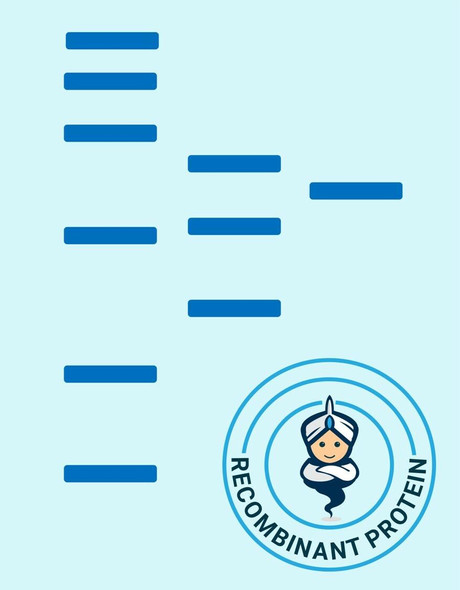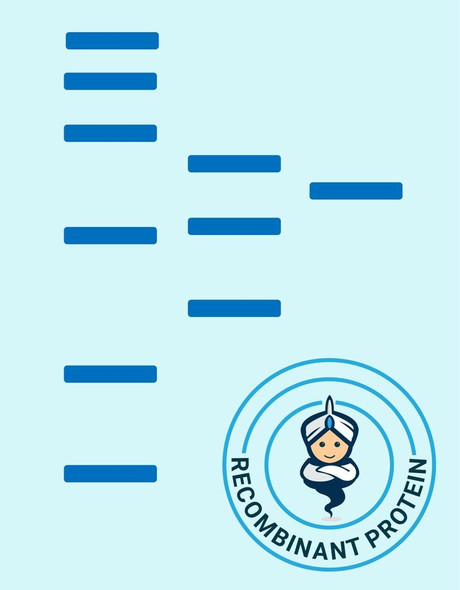Description
| Product Name: | F8 Protein Recombinant Protein |
| Product Code: | RPPB3486 |
| Size: | 500IU |
| Target: | F8 Protein |
| Synonyms: | Coagulation factor VIII, Procoagulant component, Antihemophilic factor, AHF, F8, F8C, F8B, HEMA, FVIII, DXS1253E, F8 protein. |
| Source: | Chinese Hamster Ovary Cells (CHO) |
| Physical Appearance: | Sterile Filtered White lyophilized (freeze-dried) powder. |
| Formulation: | Each 250IU vial was lyophilized from a solution containing 8mg Tween-80, 112mM NaCl, 40mg Mannitol, 10mg Trehalose, 1ng VWF and 4.2mM CaCl2. |
| Solubility: | It is recommended to reconstitute 250IU lyophilized Factor-VIII in 5ml sterile 18M-cm H2O, which can then be further diluted to other aqueous solutions. |
| Stability: | Lyophilized Factor-VIII although stable at room temperature for 3 weeks, should be stored desiccated below -18°C. Upon reconstitution Factor-VIII should be stored at 4°C between 2-7 days and for future use below -18°C.Please prevent freeze-thaw cycles. |
| Purity: | Greater than 97.0% as determined by SDS-PAGE. |
| Biological Activity: | The specific activity was found to be 7,058 IU/mg. |
Coagulation factor VIII participates in the intrinsic pathway of blood coagulation; factor VIII is a cofactor for factor IXa which, in the presence of Ca+2 and phospholipids, converts factor X to the activated form Xa. This gene produces two alternatively spliced transcripts. Transcript variant 1 encodes a large glycoprotein, isoform a, which circulates in plasma and associates with von Willebrand factor in a noncovalent complex. This protein undergoes multiple cleavage events. Transcript variant 2 encodes a putative small protein, isoform b, which consists primarily of the phospholipid binding domain of factor VIIIc. This binding domain is essential for coagulant activity. Defects in this gene results in hemophilia A, a common recessive X-linked coagulation disorder.
Antihemophilic Facor Human Recombinant produced in CHO is a glycosylated polypeptide chain having 2322 amino acids. The Factor-VIII is purified by proprietary chromatographic techniques.
| UniProt Protein Function: | F8: Factor VIII, along with calcium and phospholipid, acts as a cofactor for factor IXa when it converts factor X to the activated form, factor Xa. Defects in F8 are the cause of hemophilia A (HEMA). A disorder of blood coagulation characterized by a permanent tendency to hemorrhage. About 50% of patients have severe hemophilia resulting in frequent spontaneous bleeding into joints, muscles and internal organs. Less severe forms are characterized by bleeding after trauma or surgery. Of particular interest for the understanding of the function of F8 is the category of CRM (cross-reacting material) positive patients (approximately 5%) that have considerable amount of F8 in their plasma (at least 30% of normal), but the protein is non- functional; i.e. the F8 activity is much less than the plasma protein level. CRM-reduced is another category of patients in which the F8C antigen and activity are reduced to approximately the same level. Most mutations are CRM negative, and probably affect the folding and stability of the protein. Belongs to the multicopper oxidase family. 2 isoforms of the human protein are produced by alternative splicing. |
| UniProt Protein Details: | Protein type:Secreted, signal peptide; Secreted Chromosomal Location of Human Ortholog: Xq28 Cellular Component: extracellular space; extracellular region; plasma membrane Molecular Function:protein binding; copper ion binding; serine-type endopeptidase activity; oxidoreductase activity Biological Process: platelet activation; platelet degranulation; acute-phase response; proteolysis; blood coagulation; blood coagulation, intrinsic pathway Disease: Hemophilia A; Factor Viii Deficiency |
| NCBI Summary: | This gene encodes coagulation factor VIII, which participates in the intrinsic pathway of blood coagulation; factor VIII is a cofactor for factor IXa which, in the presence of Ca+2 and phospholipids, converts factor X to the activated form Xa. This gene produces two alternatively spliced transcripts. Transcript variant 1 encodes a large glycoprotein, isoform a, which circulates in plasma and associates with von Willebrand factor in a noncovalent complex. This protein undergoes multiple cleavage events. Transcript variant 2 encodes a putative small protein, isoform b, which consists primarily of the phospholipid binding domain of factor VIIIc. This binding domain is essential for coagulant activity. Defects in this gene results in hemophilia A, a common recessive X-linked coagulation disorder. [provided by RefSeq, Jul 2008] |
| UniProt Code: | P00451 |
| NCBI GenInfo Identifier: | 119767 |
| NCBI Gene ID: | 2157 |
| NCBI Accession: | P00451.1 |
| UniProt Secondary Accession: | P00451,Q14286, Q5HY69, |
| UniProt Related Accession: | P00451 |
| Molecular Weight: | 24,641 Da |
| NCBI Full Name: | Coagulation factor VIII |
| NCBI Synonym Full Names: | coagulation factor VIII, procoagulant component |
| NCBI Official Symbol: | F8�� |
| NCBI Official Synonym Symbols: | AHF; F8B; F8C; HEMA; FVIII; DXS1253E�� |
| NCBI Protein Information: | coagulation factor VIII; factor VIII F8B; antihemophilic factor; coagulation factor VIIIc |
| UniProt Protein Name: | Coagulation factor VIII |
| UniProt Synonym Protein Names: | Antihemophilic factor; AHF; Procoagulant componentCleaved into the following 4 chains:Factor VIIIa heavy chain, 200 kDa isoform; Factor VIIIa heavy chain, 92 kDa isoform; Factor VIII B chain; Factor VIIIa light chain |
| Protein Family: | Factor VIII intron 22 protein |
| UniProt Gene Name: | F8�� |
| UniProt Entry Name: | FA8_HUMAN |






